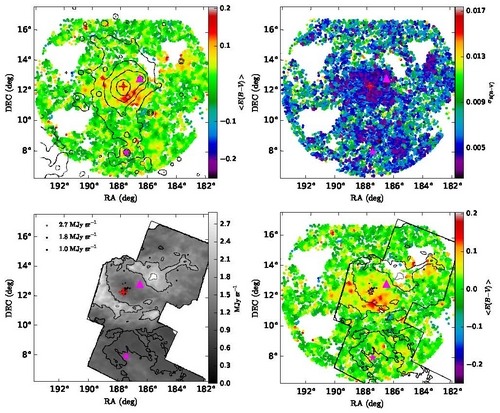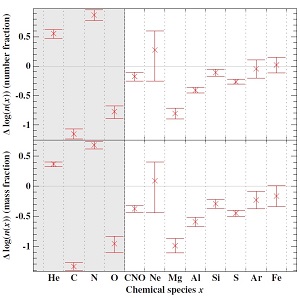Accueil
Effect of wind-driven accretion on planetary migration (Kimmig et al.)
- Details
- Published on 16 December 2019
Vol. 633
10. Planets and planetary systems
Effect of wind-driven accretion on planetary migration
 The authors compare the efficiency of the wind-driven accretion process with respect to the viscous accretion process in protoplanetary disks. They show that for the co-orbital region, this wind-driven process always injects mass from the outer edge of the co-orbital region and removes mass from the inner edge, while the viscous process does not. As a consequence, wind-driven accretion may strongly alter our formation scenarios.
The authors compare the efficiency of the wind-driven accretion process with respect to the viscous accretion process in protoplanetary disks. They show that for the co-orbital region, this wind-driven process always injects mass from the outer edge of the co-orbital region and removes mass from the inner edge, while the viscous process does not. As a consequence, wind-driven accretion may strongly alter our formation scenarios.
The GALEX Ultraviolet Virgo Cluster Survey (GUViCS) (Longobardi et al.)
- Details
- Published on 15 January 2020
Vol. 633
1. Letters
The GALEX Ultraviolet Virgo Cluster Survey (GUViCS) VIII. Diffuse dust in the Virgo intra-cluster space
 Dust is thought to be destroyed by sputtering in galaxy clusters, which are rich in X-ray emitting hot gas. However, some dust may still exist in shielded regions or from gas tails that have just been stripped from galaxies. Measurements of the amount of dust in clusters have derived extinctions between AV=0.004 and 0.5. The present work represents the first detection of diffuse dust in the intra-cluster medium of the Virgo cluster out to ~0.4 virial radius. The authors have used the near-ultraviolet-I colors of about 12000 background galaxies with redshifts 0.02 < z < 0.8, and find an average reddening E(B - V) ~ 0.042 mag within 1.5 degrees or 0.3 virial radius from the cluster’s center. Assuming a Large Magellanic Cloud extinction law, they derived an average visual extinction AV = 0.14, leading to a total dust mass of Md = 2.5 10^9Mo and hence a dust-to-gas mass ratio of Md/Mg = 3.0 x 10^-4, which is much lower than in the Milky Way. The far-infrared emission of the dust was not detected by Herschel at 250 micron; this means that either the dust temperature should be low, about 10 K, or that the dust has lower emissivity than usual. Nevertheless, this diffuse dust in the Virgo cluster must originate from the galaxies through tidal or ram-pressure stripping.
Dust is thought to be destroyed by sputtering in galaxy clusters, which are rich in X-ray emitting hot gas. However, some dust may still exist in shielded regions or from gas tails that have just been stripped from galaxies. Measurements of the amount of dust in clusters have derived extinctions between AV=0.004 and 0.5. The present work represents the first detection of diffuse dust in the intra-cluster medium of the Virgo cluster out to ~0.4 virial radius. The authors have used the near-ultraviolet-I colors of about 12000 background galaxies with redshifts 0.02 < z < 0.8, and find an average reddening E(B - V) ~ 0.042 mag within 1.5 degrees or 0.3 virial radius from the cluster’s center. Assuming a Large Magellanic Cloud extinction law, they derived an average visual extinction AV = 0.14, leading to a total dust mass of Md = 2.5 10^9Mo and hence a dust-to-gas mass ratio of Md/Mg = 3.0 x 10^-4, which is much lower than in the Milky Way. The far-infrared emission of the dust was not detected by Herschel at 250 micron; this means that either the dust temperature should be low, about 10 K, or that the dust has lower emissivity than usual. Nevertheless, this diffuse dust in the Virgo cluster must originate from the galaxies through tidal or ram-pressure stripping.
A stripped helium star in the potential black hole binary LB-1 (A. Irrgang et al.)
- Details
- Published on 10 January 2020
Vol. 633
In section 1. Letters to the Editor
A stripped helium star in the potential black hole binary LB-1

Very recently, the single-lined spectroscopic binary system LB-1 at a distance of 2.3kpc (inferred from the Gaia DR2 parallax) was claimed to contain a black hole of about 70 solar masses. This result is surprising, and would be completely at odds with current stellar evolution models as these do not predict such massive black holes in an environment that is as metal-rich as the Galactic solar neighborhood. In this Letter, the authors present a quantitative spectroscopic analysis of the visible component in LB-1 which reveals that this object is not an ordinary main sequence B-type star as previously assumed. Instead, the derived abundance pattern shows heavy imprints of hydrogen burning via the CNO bi-cycle, indicating that it is actually a stripped helium star. This result overturns the previous interpretation: the revised nature of the visible component significantly lowers the mass estimate to for the unseen companion, allowing values as low as 2-3 Msun; this is no longer in contradiction with stellar evolution models. The exact nature of the companion remains ambiguous for the time-being: it could be an ordinary black hole, a (massive) neutron star, or even a relatively unevolved main sequence star.
A thin shell of ionized gas as the explanation for infrared excess among classical Cepheids (V. Hocdé et al.)
- Details
- Published on 10 January 2020
Vol. 633
6. Interstellar and circumstellar matter
A thin shell of ionized gas as the explanation for infrared excess among classical Cepheids
Cepheids have played a crucial role in the distance scale and determination of the present value of the Hubble constant H_0. This distance ladder is, however, mainly based on the period-luminosity relation and uncertainties around this relation are one of the largest contributors to the error of H_0. The IR excess of classical Cepheids is poorly understood but it is likely to affect the PL relation in a systematic way. The authors built a phase-independent spectral energy distribution (SED) of a sample of Cepheids from visible to mid-IR wavelengths, compared the SED to atmospheric models, and derived the IR excess features. Furthermore, they showed that the excess cannot be explained by a hot or cold dust model of the circumstellar environment. A free-free emission from a thin shell of ionized gas around Cepheids can reproduce the observed IR excess. Further investigation is needed to understand the impact of the presence of an ionized gas shell on the PL relation


